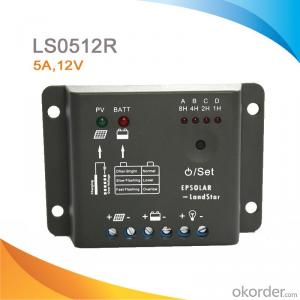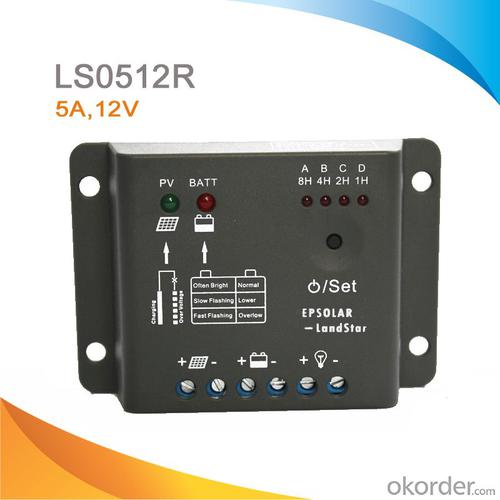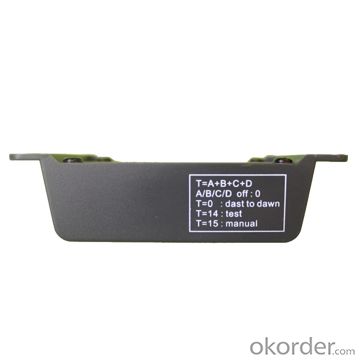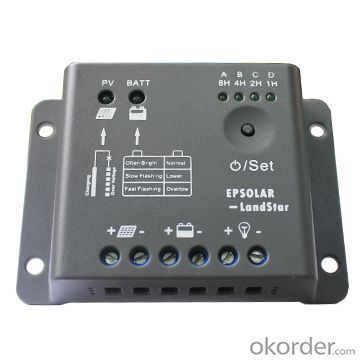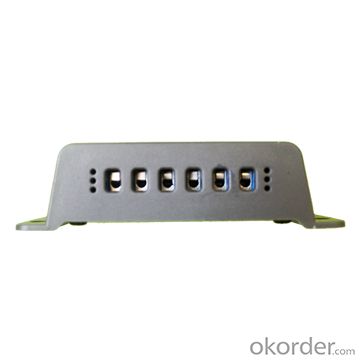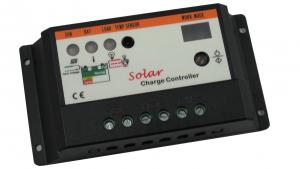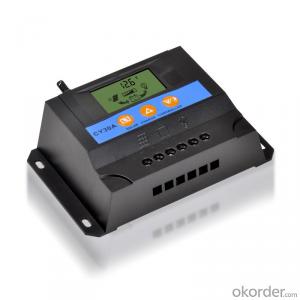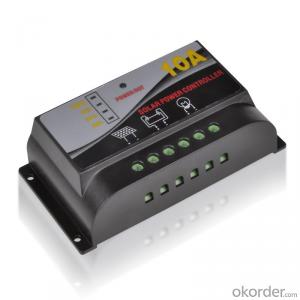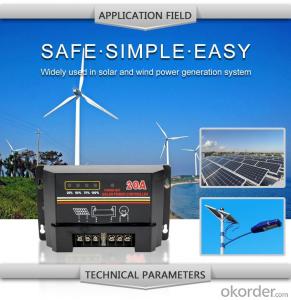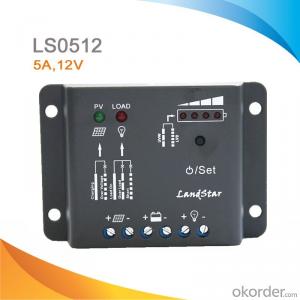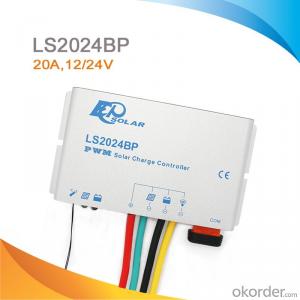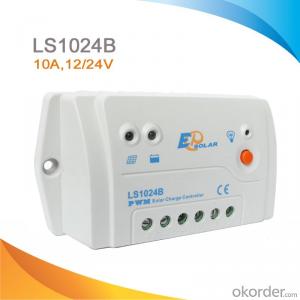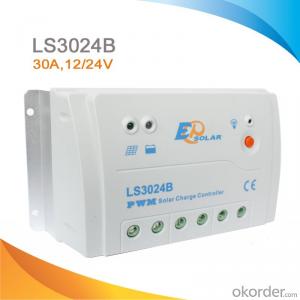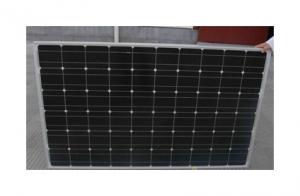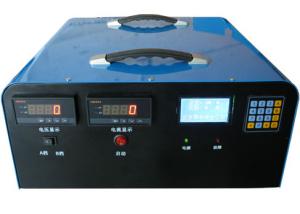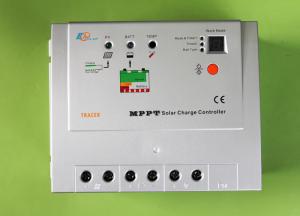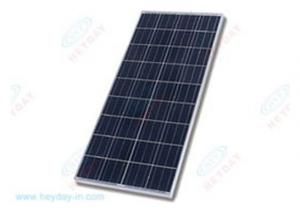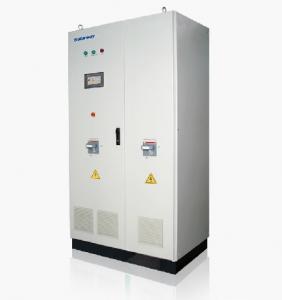Resol Solar Heating Controllers PWM Solar Lighting Regulator 5A, 12V, LS0512R
- Loading Port:
- China Main Port
- Payment Terms:
- TT or LC
- Min Order Qty:
- -
- Supply Capability:
- -
OKorder Service Pledge
OKorder Financial Service
You Might Also Like
Descriptions
Our solar controllers are designed for solar home system, ideal for rural electrification systems, and many advantages compared to other controllers: Ideal for small off-grid solar lighting system that needs light and timer control.
Features:
·High efficient Series PWM charging, increase the battery lifetime and improve the solar system performance.
·Use MOSFET as electronic switch, without any mechanical switch
·Widely used, automatically recognize day/night.
·Only one key solve all setting simply
·Intelligent timer function with 1-12 hours option
·Adopt temperature compensation, correct the charging and discharging parameters automatically and improve the battery lifetime.
Electronic Protections:
·over charging
·over discharging
·overload
·short circuit
·Reverse protection for battery
Specification:
Electrical parameters | LS0512R |
Nominal System Voltage | 12VDC |
Rated Battery Current | 5A |
Max. Battery Voltage | 16V |
Charge Circuit Voltage Drop | ≤0.26V |
Discharge Circuit Voltage Drop | ≤0.15V |
Self-consumption | ≤6mA |
Overall dimension | 97 x 66x 25mm |
Terminal | 2.5mm2 |
Net weight | 0.05kg |
Working temperature | -35℃ to +55℃ |
Humidity | 10%-90% NC |
Enclosure | IP30 |
Battery Voltage Parameters (temperature at 25℃) | |
Battery charging setting | Sealed |
Equalize Charging Voltage | 14.6V |
Boost Charging Voltage | 14.4V |
Float Charging Voltage | 13.8V |
Low Voltage Reconnect Voltage | 12.6V |
Low Voltage Disconnect Voltage | 11.1V |
Equalize Duration | 2 hours |
Boost Duration | 2 hours |

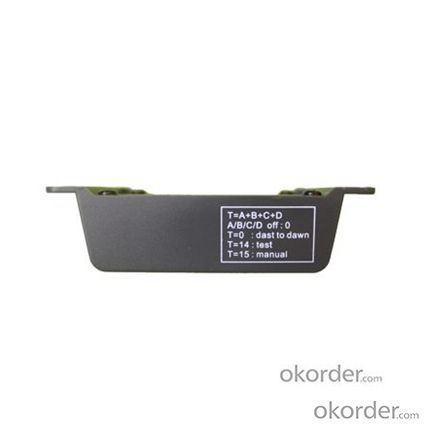
- Q: How does a solar controller handle battery temperature monitoring?
- A solar controller handles battery temperature monitoring by using a built-in temperature sensor. This sensor measures the temperature of the battery and adjusts the charging parameters accordingly. If the battery temperature is too high, the controller may reduce the charging current to prevent overcharging and overheating. Similarly, if the battery temperature is too low, the controller may increase the charging current to compensate for reduced battery efficiency. This monitoring and adjustment process helps to optimize battery performance and prolong its lifespan.
- Q: How does a solar controller handle battery capacity monitoring?
- A solar controller handles battery capacity monitoring by measuring the voltage and current going in and out of the battery. It constantly monitors the battery's state of charge and adjusts the charging and discharging rates accordingly to prevent overcharging or deep discharge, ensuring optimal battery performance and longevity.
- Q: What is the purpose of the low voltage disconnect feature on a solar controller?
- In order to safeguard the batteries from over-discharge, the low voltage disconnect feature on a solar controller serves a crucial purpose. When the battery's voltage drops below a certain level, irreversible damage can occur, significantly reducing its lifespan. By monitoring the battery voltage, the low voltage disconnect feature effectively disconnects any load, such as appliances or devices, from the battery once the voltage falls below a predetermined threshold. This action prevents excessive drainage of the battery, ensuring that it retains a sufficient charge for proper functioning and longevity. Consequently, by disconnecting the load, the low voltage disconnect feature plays a vital role in protecting and optimizing the battery's performance within a solar power system.
- Q: How do MPPT solar controllers work?
- MPPT solar controllers work by continuously tracking and adjusting the electrical impedance of the solar panel to maximize the power output. They achieve this by measuring the voltage and current of the panel, and then calculating the optimal operating point where the output power is highest. This information is used to dynamically adjust the load impedance, allowing the solar panel to operate at its peak efficiency and extract maximum energy from the sunlight.
- Q: Can a solar controller be used with solar panel bypass diodes?
- Solar panel bypass diodes can indeed be utilized alongside a solar controller. It is customary to incorporate bypass diodes in solar panel setups to counteract power losses caused by shading or partial shading. By offering alternative paths for current to bypass shaded cells, bypass diodes assist in minimizing the impact of shaded cells on the overall performance of the solar panel array. On the other hand, a solar controller's role revolves around regulating the charging and discharging of a battery bank that is connected to the solar panel system. Its purpose is to optimize the charging process and prevent any instances of overcharging or over-discharging of the batteries. Ordinarily, the solar controller is positioned between the solar panels and the battery bank. Since the bypass diodes are integrated within the solar panels themselves, the solar controller does not have direct interaction with them. However, it manages the overall solar panel array and battery bank, ensuring efficient energy transfer and storage. As a result, using a solar controller in conjunction with solar panel bypass diodes is not only feasible but also advised for a properly functioning solar power system.
- Q: How do you protect a solar controller from theft?
- One way to protect a solar controller from theft is by installing it in a secure and inaccessible location, such as inside a locked cabinet or enclosure. Additionally, you can use tamper-proof screws or bolts to secure the controller in place and make it more difficult to remove. Adding signage or warning labels indicating that the controller is under surveillance or protected by security measures can also act as a deterrent.
- Q: How does a solar controller handle reverse polarity or incorrect wiring connections?
- A solar controller is designed to handle reverse polarity or incorrect wiring connections in a few different ways. Firstly, most solar controllers have built-in protection mechanisms such as fuses or circuit breakers that prevent damage to the controller and connected solar panels in case of reverse polarity or incorrect wiring. These protection devices help to disconnect the charging circuit and prevent any potential electrical damage. Additionally, many solar controllers have built-in LED indicators or LCD displays to notify the user about any wiring issues. These indicators or displays can show error codes or warning messages when reverse polarity or incorrect wiring connections are detected. This allows the user to quickly identify and rectify the wiring problem before any damage occurs. Furthermore, modern solar controllers may also have built-in safety features like automatic shutdown or overload protection. These features are designed to protect the controller and connected devices by automatically shutting down the charging circuit in case of reverse polarity or excessive current flow due to incorrect wiring. This prevents any potential damage to the solar panels, batteries, or other connected devices. In summary, a solar controller handles reverse polarity or incorrect wiring connections through the use of built-in protection mechanisms, LED indicators or LCD displays for error notification, and safety features like automatic shutdown or overload protection. These features collectively ensure the safe and efficient operation of the solar system by preventing any potential damage or electrical hazards.
- Q: Can a solar controller be used with solar string inverters?
- Solar string inverters can be used in conjunction with solar controllers, also known as charge controllers. These controllers are responsible for regulating the charging and discharging of batteries in a solar power system, preventing overcharging and over-discharging and extending battery lifespan. On the other hand, solar string inverters are utilized to convert the direct current (DC) generated by solar panels into alternating current (AC) electricity. This AC electricity can be used to power household appliances or be fed into the grid. Although solar controllers are commonly used in off-grid or hybrid solar systems with battery storage, they can still be employed alongside solar string inverters. In such setups, the solar controller regulates battery charging, while the solar string inverter converts DC electricity from solar panels into AC electricity for immediate use or grid integration. The utilization of a solar controller with solar string inverters offers added control and protection to the battery storage system. This ensures optimal battery charging and safeguards against damage caused by overcharging or deep discharging.
- Q: How do you connect a solar controller to a solar panel?
- To connect a solar controller to a solar panel, you will need to ensure that the solar panel's positive (+) terminal is connected to the positive (+) terminal of the solar controller and the negative (-) terminal of the solar panel is connected to the negative (-) terminal of the solar controller. This can be achieved by using appropriate connectors or wiring, making sure to follow the manufacturer's instructions and safety guidelines.
- Q: Can a solar controller be used with solar panel ground fault detection systems?
- Yes, a solar controller can be used with solar panel ground fault detection systems. A solar controller is responsible for regulating the voltage and current flow from the solar panels to the battery or grid. It ensures that the solar panels are operating at their maximum efficiency and keeps track of the charging process. On the other hand, a ground fault detection system is designed to detect any ground faults or leakage currents in the solar panel system. It monitors the electrical connections and detects any abnormalities that may pose a safety risk. In most cases, the solar controller and ground fault detection system work independently of each other. The solar controller focuses on optimizing the energy production and storage, while the ground fault detection system focuses on ensuring the safety of the system. However, it is possible to integrate the two systems together. Some advanced solar controllers may have built-in ground fault detection capabilities or can be connected to an external ground fault detection system. This integration allows for more comprehensive monitoring and protection of the solar panel system. In conclusion, while a solar controller and a ground fault detection system serve different purposes, they can be used together to enhance the overall performance and safety of a solar panel system.
Send your message to us
Resol Solar Heating Controllers PWM Solar Lighting Regulator 5A, 12V, LS0512R
- Loading Port:
- China Main Port
- Payment Terms:
- TT or LC
- Min Order Qty:
- -
- Supply Capability:
- -
OKorder Service Pledge
OKorder Financial Service
Similar products
Hot products
Hot Searches
Related keywords
